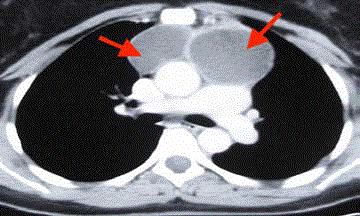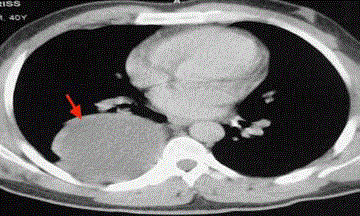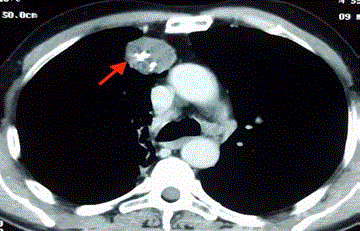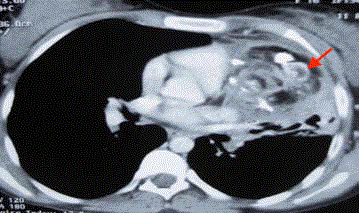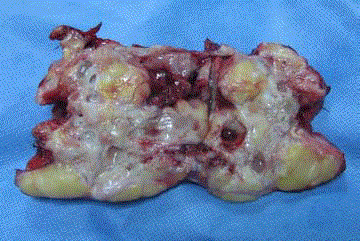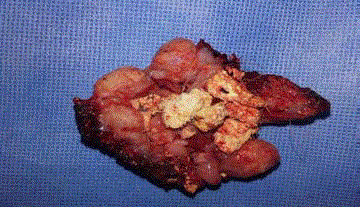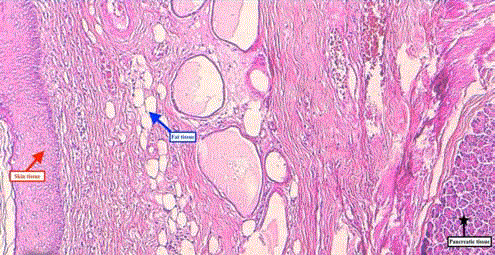Research Article
Mature Mediastinal Teratoma: The Longue Timeline from Onset of Symptoms to Definitive Management
Sani Rabiou1*, Boubacar Efared2, Hicham Harmouchi1, Marouane Lakranbi1, Mounia Serraj3,4, Yassine Ouadnouni1,4 and Mohamed Smahi1,4
1Department of Thoracic Surgery, CHU Hassan II, Morocco
2Department of Pathology, CHU Hassan II, Morocco
3Department of Respiratory Diseases, CHU Hassan II, Morocco
4Department of Medicine and Pharmacy, Sidi-Mohamed-Ben-Abdellah University, Morocco
*Corresponding author: Sani Rabiou, Department of Thoracic Surgery, CHU Hassan II, Fez, Morocco
Published: 10 Aug, 2018
Cite this article as: Rabiou S, Efared B, Harmouchi H,
Lakranbi M, Serraj M, Ouadnouni Y,
et al. Mature Mediastinal Teratoma:
The Longue Timeline from Onset of
Symptoms to Definitive Management.
Clin Surg. 2018; 3: 2063.
Abstract
Background: Mediastinal teratomas are rare. Nevertheless, they represent the most frequent
mediastinal germ cell tumours. The aim of our work is to study the anatomoclinic and radiological
features of these mediastinal tumours.
Methods: This is a retrospective study carried out in the CHU Hassan II department of thoracic
surgery between June 2009 and May 2017, collecting 8 teratomas from the mediastinum.
Results: They are 5 women and 3 men with an average age of 37 years (extremes of 16 to 65 years).
The main sign revealing was chest pain in three cases. We noticed a complex rupture in the bronchi
and the lung in one case, associated with a cutaneous fistula in another patient. The radiological
assessment showed an evocative aspect of a mediastinal teratoma with ranges of variable densities:
solid, fluid, fat and calcium only in three patients. The surgical exploration by posterolateral
thoracotomy had allowed the complete resection of the tumor in the cases. Anatomopathological
examination of the room confirmed the diagnosis of a mature teratoma in all patients.
Conclusion: The clinical picture of mediastinal mature teratomas is non-specific. The association
with a rupture testifies to the long evolution of this disease. The imaging is often atypical showing
entirely cystic lesions.
Keywords: Tumor of the mediastinum; Mature teratoma; Teratoma ruptured; Surgery
Background
Mature teratomas of the mediastinum are rare tumours. They represent 10% of mediastinal tumours, 50% to 70% of mediastinal germ tumours, and 80% to 88% of mediastinal teratomas [1]. They are part of non-seminomatous germ cell tumours and correspond to formations derived from one or more embryonic layers (ectoblast, entoblast and mesoblast). Mature or immature, they may be cystic or solid. Mature teratomas are composed exclusively of well differentiated tissues of adult type. They usually sit in the anterior mediastinum. It is a tumor that remains long asymptomatic. This slow evolution, accounting for the delayed diagnosis which can often evolve towards a rupture in the adjacent organs. Treatment is surgical resection without delay [2]. The anatomopathological expertise confirms the diagnosis by eliminating the presence of an immature component.
Methods
This retrospective study, concerning the cases of patients operated for mature teratoma of the mediastinum, in the department of thoracic surgery of CHU Hassan II of Fez, between June 2009 and May 2017. We collected data on age, sex, duration of symptomatology. The CT scan allowed us not only to locate the lesion in the different compartments of the mediastinum but also to investigate the presence of a possible rupture in the intra-thoracic organs. The management data included the type of surgical approach, the type of gesture, the type of postoperative complications, as well as the subsequent evolution of patients after surgery. All these elements coupled with the results of the anatomopathological assessment had been reported on a previously established fact sheet.
Results
They were 5 women and 3 men with an average age of 37 years (range 16-65 years). Main sign revealing was chest pain in three cases. In one case, it is a complex rupture in the bronchi and the lung, associated with a cutaneous fistula with sebum and hair in a patient. In another case, it was a developer hydro pneumothorax. We noted the presence of trichoptysis (sputum causing hairs) in a patient with a ruptured teratoma in the lung and bronchi. The delay between the first sign and the diagnosis was between 5 and 12 months. Thoracic computed tomography showed an evocative appearance of a mediastinal teratoma, with ranges of variable densities: solid, fluid, fat and calcium, in only three patients. In three cases it was a completely cystic lesion, one of which was posterior mediastinal (Figure 1-3). Thoracic computed tomography showed a compressive hydro pneumothorax without tumor visualization in 1 case. In 2 patients we observed a mediastino pulmonary cystic lesion with calcium and fatty contents with air bubbles, indicating communication with the bronchial tree (Figure 4). The approach was a conservative posterolateral thoracotomy in all cases. Tumor resection was associated with Lingula resection in 2 patients, flattening of a fistulous tract in one case, and pleuro pulmonary decortication in a patient with a ruptured cystic teratoma in the pleural cavity. The operative sequences were marked by the occurrence of pneumopathy with atelectasis in the 2 patients operated for a ruptured teratoma in the bronchi and the lung. The management consisted of a double antibiotic therapy associated with a kinesia active respiratory therapy after a bronchial fibroaspiration. Another patient had a postoperative pyothorax that was drained with good progress. The anatomopathological examination of the surgical specimens (Figure 5-7) concluded that a mature benign teratoma was present in all patients. With an average follow-up of 19 months, no cases of death were recorded. (Table 1) gives the clinical and paraclinical summary as well as the modalities of management of all the patients.
Figure 1
Figure 2
Figure 3
Figure 4
Figure 4
Mediastinal window CT scan showing a multi-component
mediastinal process (fluid, fat, tissue and calcium) with adjacent pulmonary
lesion related to bronchial fistulisation.
Figure 5
Figure 5
Macroscopic appearance of a mature teratoma with a fatty,
cartilaginous and hairy contingent (Patient Number 6).
Figure 6
Figure 6
Opening of the surgical specimen (patient number 3) showing the
presence of greasy, cartilaginous tissues, sebum and hairs.
Figure 7
Figure 7
Histological view showing a mature teratoma with skin, fat ant
mature pancreatic tissue (HESx200).
Table 1
Table 1
Characteristics, clinical, paraclinic and modalities of management of all patients( M=Male, F= Female).
Discussion
Mediastinal mature teratoma is a tumor of the young adult,
with an age of discovery between 30 to 40 years [1], in our series the
average age was 33 years with an identical frequency of both sexes.
The preferred seat is the anterior mediastinum, less than 3% are
posterior mediastinal [3]. The discovery of a mediastinal teratoma is
not as fortuitous, as reported by several authors [4-6]. The teratoma
is revealed either by a symptomatology of borrowing or by a
complication. Five of our patients were symptomatic, 3 of who had
fistulization. This fistulization of the teratomas can be explained by
[7]:
• The effect of proteolytic enzymes, which are secreted by
pancreatic, salivary or intestinal contingents;
• Chronic inflammation with an accumulation of sebaceous
products that induce a macrophage reaction and rupture of the tumor
wall;
• Ischemia related to the rapid increase in the size of the tumor
mass;
• And possibly the infection of the tumor mass by the hematogenic
route which weakens its wall.
Computed tomography is the exam of choice. It allows evoking
the diagnosis, when it shows an anterior mediastinal seat formation
with several components (tissue, fat, liquid and calcium). However,
imaging is often atypical, showing an entirely cystic process without
any other orientation [8-11]. In our series, three patients had a
completely cystic mass, one of which was posterior mediastinal. The
differential diagnosis is always posed with another germline tumor, a
hydatid cyst of mediastinal seat and a neurogenic tumor. It is difficult
to evaluate the fate of the teratoma before a therapeutic abstention,
because of the risk of rupture or fistulization and malignant
transformation [8,9,12]. Therefore, surgical excision of the teratoma
remains essential. The surgical excision of the mediastinal mass will,
on the one hand, be aimed at histopathological diagnosis and, on the
other hand, with a therapeutic aim [1,3,9].
Conclusion
Mediastinal teratomas may be: mature, immature or cancerized. The clinical picture of mediastinal mature teratomas is non-specific. The imaging is often atypical showing entirely cystic lesions. The most complete surgical excision of these tumours remains the only therapeutic approach possible.
References
- Chetaille B, Massard G, Falcoz PE. Mediastinal germ cell tumors: anatomopathology, classification, teratomas and malignant tumors. Rev Pneumol Clin. 2010;66(1):63-70.
- Mayeur D, Akkad R, Cornelius A, Bendaoud S, Porte H. Chamberlain biopsy is not necessary when mature teratoma is evident on imagery. Rev Mal Respir. 2014;31(1):57-60.
- Smahi M, Achir A, Chafik A, Al Aziz AS, El Messlout A, Benosman A. Mediastinal mature teratoma: about 12 cases. Ann Chir. 2000;125:965-71.
- Rabiou S, Ghalimi J, Lakrambi M, Ouadnouni Y, Smahi M. Posterior Mediastinal Mature Teratoma: A Case Report and Literature Review. CRCM. 2014;3(3):122-4.
- Ayadi-Kaddour A, Ismail O, Hassen F, Smati B, Djilani H, Kilani T, et al. Benign mature teratomas of the mediastinum. Rev Mal Respir. 2008;25(5):531-8.
- Allen MS. Presentation and management of benign médiastinal teratomas. Chest Surg Clin N Am. 2002;12(4):659-64.
- Boussetta K, Jaziri F, Bousnina D, Alaoui N, Naherzi A, Kilani T, et al. Apropos of a mediastinal teratoma invading the lung. Arch Pediatr. 2001;8:1344-7.
- Gourmelon C, Mallet JP, Devoise J, Poujol JL, Guerzider P, Torrent J, et al. Tératome mature médiastinal fissuré dans la plèvre: à propos d’un cas. Rev Mal Respir. 2007;24:1184.
- Long P, Ducloux G, Fleury B, Couraud G, Conriet C. Mediastinal teratoma disclosed by pericarditis. Rev Med Interne. 1989;10(2):150-1.
- eduneau G, Cuvelier A, Héliot PH, Métayer J, Muir JF. Mediastinal teratoma with recurrent encysted pleural effusion. Rev Mal Respir. 2002;19(3):367-70.
- Zidane A, Arsalane A, Atoini F, Kabiri EH. Mature mediastinal teratoma mimicking a thoracic extrapulmonary hydatid cyst. Rev Pneumol Clin. 2008;64(3):141-2.
- Abid H, Neji H, Haddar S, Ammar I, Ayadi L, Msaad S, et al. Mediastinal mature teratoma with spontaneous malignant transformation. Rev Mal Respir. 2013;30(5):424-8.

